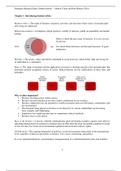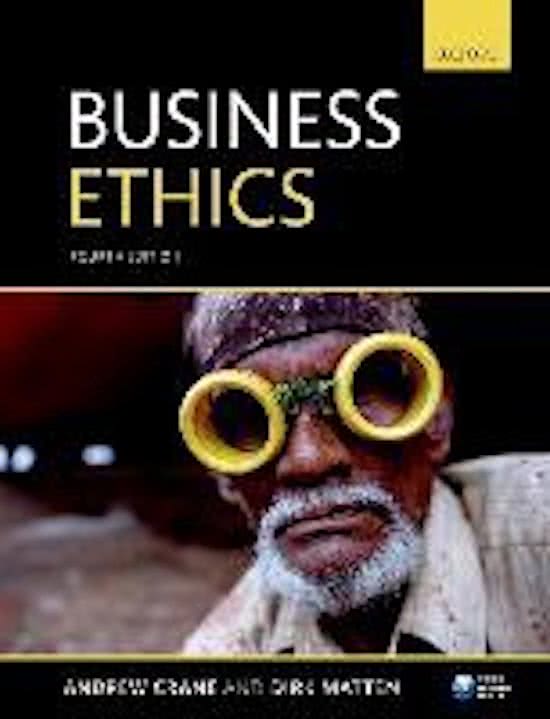Summary Business Ethics (fourth edition) – Andrew Crane and Dirk Matten (2016)
Chapter 1. Introducing business ethics
--------------------------------------------------------------------------------------------------------------------------------
Business ethics = The study of business situations, activities, and decisions where issues of morally right
and wrong are addressed.
Ethical misconducts = Corruptions, illegal practices, conflict of interests, public accountability and insider
trading.
Ethics is about the grey areas of business. It is not covered
by the law.
It is about better decisions, not the right decisions good
judgement.
Morality = The norms, values and beliefs embedded in social processes which define right and wrong for
an individual or a community.
Ethics = The study of morality and the application of reason to elucidate specific rules and principles that
determine morally acceptable courses of action. Ethical theories are the codifications of these rules and
principles.
Why is ethics important?
Business has huge power within society.
Business has the potential to provide a major contribution to our societies.
Business malpractice has the potential to conflict enormous harm on individuals, communities and
the environment.
The demands being placed on business to be ethical by its various stakeholders are becoming
more complex and challenging.
Employees face significant pressure to compromise ethical standards.
Business faces a trust deficit.
Race to the bottom = A process whereby multinationals pitch developing countries against each other by
allocating foreign direct investment to countries that can offer them the most favourable conditions in terms
of low tax rates, low levels of environmental regulation and restricted workers’ rights.
Globalization = The ongoing integration of political, social and economic interactions at the transnational
level, regardless of physical proximity or distance. Two causes: technology and politics.
It is not: internationalisation, westernisation, homogenisation. It is deterritorialisation (Jan Aart Scholte).
1
,Summary Business Ethics (fourth edition) – Andrew Crane and Dirk Matten (2016)
Why is globalization central to business ethics?
1) Cultural issues = How to deal with different values?
2) Legal issues = Which legal framwork should be followed? Its own country or?
3) Accountability issues = Multinationals are becoming as powerful as governments. Should they
become also more accountable as governments are?
Sustainability = The long-term maintenance of systems according to environmental, economic and social
considerations. It is the development that meets the needs of the present without compromising the ability
of future generations to meet their own needs. Two causes: explosive population growth and rapid economic
development of emerging economies. It is about intergenerational equity!
TBL = Tripple bottom line (John Elkington)
Business does not have one single goal, namely adding economic value but that it has an extended goal with
necessitates adding environmental and social value too.
Environmental = use of resources
Economic = stable markets, long-term economic performance of company and the market
Social = affluent customers, social justice
Figures in the book
Figure 1.4 on page 17 the differences in business ethics across organizational types.
Figure 1.5 on page 23 the ethical impacts of globalization on different stakeholder groups.
Figure 1.6 on page 24 the regional differences from a business ethic perspective.
Chapter 2. Framing business ethics
--------------------------------------------------------------------------------------------------------------------------------
Corporation = Legal entity, with legal rights and responsibilities similar, but not identical, to those
enjoyed by individuals. Right to sue, issue stock, have property and limited liability.
Although corporations are legally liable for the things they do, can they also be held morally responsible?
Milton Friedman The social responsibility of business is to increase its profits. Arguments are:
1) Only human beings have a moral responsibility for their actions.
2) Managers’ responsibility to act solely in the interests of shareholders. Any other purpose is wrong.
3) Social issues and problems are the proper province of the state rather than corporate managers.
Statement for Friedman’s first argument: Corporations do not have moral responsibility.
Only human beings have a moral responsibility.
Corporations are set up by human beings, so it is those human beings that have moral
responsibility.
Statement against Friedman’s first argument: Corporations do have moral responsibility.
Corporations have a legal identity.
Corporations have an internal decision structure that directs decisions in line with predetermined
goals and purposes (agency argument).
Organizational culture is the set of beliefs and values that lay out what is generally regarded as
right or wrong in the corporation, moral principles and moral commitment.
Corporations present themselves and interact with customers and other stakeholders as if they
were distinct persons (functional identity).
2
, Summary Business Ethics (fourth edition) – Andrew Crane and Dirk Matten (2016)
Statement against Friedman’s second argument: Managers have to act in the interests of stakeholders
Two theories supporting this view:
1) Corporate social responsibility
2) Stakeholder theory
Economic/business reasons for CSR
Enhance long-term revenues (satisfying customers)
Reduce costs (save energy and reducing waste)
Manage risk and uncertainty (forestall legislation and ensure greater corporate independence from
government)
Maintaining the social license to operate (support)
Enlightened self-interest, profit maximization under the cloak of social responsibility.
Moral reasons for CSR
The externalities argument = All corporations have social impacts where to deal with.
The power argument = Use power and resources responsible.
The dependency argument = Corporations rely on the contribution of a wide set of stakeholders
in the society, not just shareholders.
Four-part model of CSR – Carroll
Carroll regards CSR as a multilayered concept, which can be differentiated into 4 interrelated aspects:
1) Economic responsibility = The basis, economic functioning, required by the society.
2) Legal responsibility = Law, required by the society.
3) Ethical responsibility = Do what is right and fair, expected by the society.
4) Philanthropic responsibility = Improve quality of life of people/society, desired by the society.
Basis types of CSR strategies
Traditional CSR Contemporary CSR
Focus Risk Reward
Driver Image, brand, public acceptance Performance, markets, products
Relation to the bottom line No direct contribution: CSR is Integral goal: CSR is value
value distribution creation
Responsiveness Reaction, defence Accommodation, pro-action
Motto CSR is bolt-on CSR is built-in
Outcomes of CSR (corporate social performance)
1) Social policies
2) Social programmes (achieving policies)
3) Social impacts (concrete change through programmes)
Unlike the CSR approach, which strongly focuses on the corporation and its responsibilities, the stakeholder
approach starts by looking at various groups to which the corporation has a responsibility.
Stakeholder = Any group or individual who can affect or is affected by the achievement of the organization’s
objectives (Freeman). They have legitimate claims towards the organization:
Legal perspective = It is not true that only shareholders hold a stake in the corporation.
Economic perspective = The agency problem, shareholders often have short-term interests as
owners, as compared to customers, employees or suppliers. Why should the interest of the former
prevail?
3





